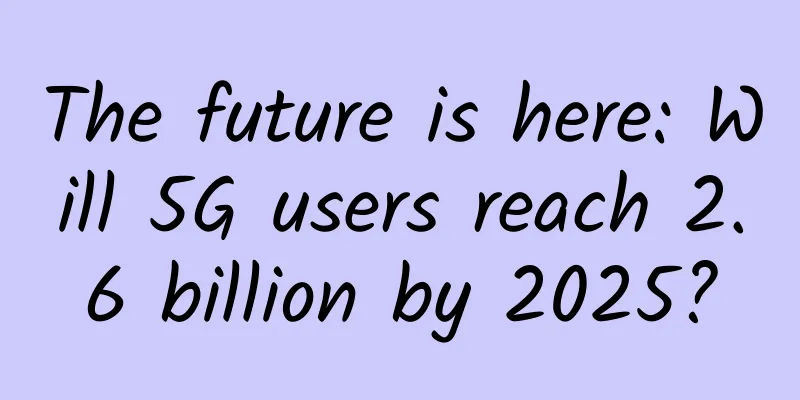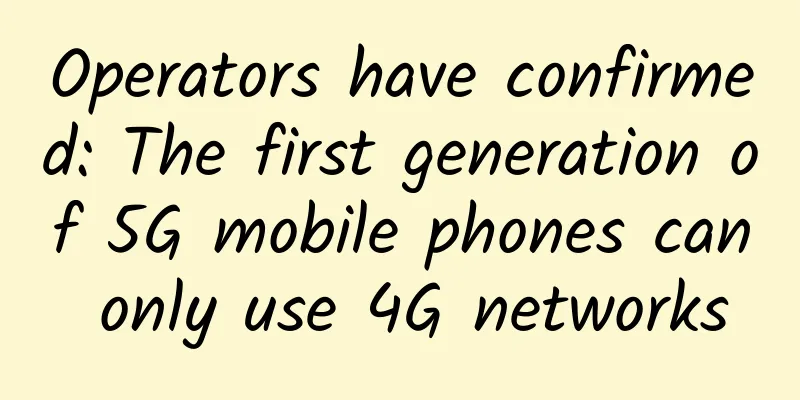The future is here: Will 5G users reach 2.6 billion by 2025?

|
This article is reproduced from the public account "Reading Core Technique" (ID: AI_Discovery) The discussion about 5G has been going on for many years, from conceptualization to testing and then to actual implementation. In 2019, 5G was finally officially launched. If the Ericsson Mobility Market Report is an indicator of the trend, then the growth rate of 5G will be faster than we think. As of the fourth quarter of 2019, the total number of 5G users was close to 13 million.
So far, 50 service providers from around the world have pledged to launch 5G services in 2020, but the COVID-19 pandemic has limited its global rollout, and some people have been influenced by conspiracy theories, and the act of vandalizing 5G base stations has intensified. Rumors about conspiracy theories have grown so numerous that the World Health Organization has had to come out and refute them, and even Twitter has begun adding fact-checking labels to tweets linking 5G to the new coronavirus. Early Experimentation and Late Bloomer Before the COVID-19 pandemic, several countries from around the world were already enabling 5G on a large scale. In South Korea, all telecom operators have been running commercial 5G services since April 2019. By March 2020, South Korea had more than 5 million 5G subscribers. Similarly, around 90% of the population in Switzerland now has access to 5G. As far as Southeast Asia and Oceania are concerned, 5G network promotion is already underway. In Australia, 5G is available for mobile broadband as well as fixed wireless services. Southeast Asian countries have also conducted 5G trials, and some markets are waiting for spectrum allocation in order to officially launch 5G. In addition to 5G, smartphone subscriptions in Southeast Asia and Oceania are also expected to exceed the 1 billion mark by 2025. Ericsson said that by 2025, the lowest 5G penetration will come from the Middle East and Africa (7%), Latin America (11%) and India (11%). However, India is expected to grow its LTE numbers from 48% in 2019 to 80% in 2025. This means that the country will replace most of its 2G and 3G connections with 4G users by 2025. Meanwhile, 5G services are expected to be available in India in 2022. The largest 5G market Among other regions, Northeast Asia, Western Europe, and North America are expected to have the highest 5G penetration rates of 56%, 55%, and 74%, respectively, by 2025. Most countries in these regions are developed economies, and it is foreseeable that the penetration rates here will be high. Ericsson Mobile Market Report – November 2019 North America has a 91% share of 4G users, the highest among all regions in the world. The region has already started commercializing 5G. Ericsson predicts that by 2025, the number of 5G users in North America will grow to nearly 320 million. The same is true in Northeast Asia. By the end of this year, LTE (4G) subscriptions are expected to reach 88%, with China alone accounting for 1.4 billion. Since 2019, China has issued licenses for 5G commercial services to four service operators. Despite the COVID-19 pandemic, China has also been carrying out 5G commercial services. Japan's three largest operators launched 5G in March, but the coronavirus pandemic has made it more challenging for customers to accept 5G. Similar to North America, Western Europe also mainly uses 4G, accounting for 69% of the region. Forecast data shows that by 2025, 5G users in the region will account for 55%, 4G users will account for 42%, and 3G users will account for only 2%. Before the outbreak of the new crown epidemic, 20 service operators launched 5G services in the region. After the epidemic in Europe is under control, more 5G service providers may follow. How will 5G change the trend of mobile communications? Ericsson believes that with 5G technology, the average consumption of mobile data will rise from 7.2 GB per month to 24 GB. It should be emphasized here that video consumption has become the dominant mobile broadband traffic, which is a well-known fact, and the COVID-19 pandemic will only accelerate this trend. Ericsson predicts that video traffic in mobile networks will continue to grow at an annual rate of 30% by 2025. Video traffic will grow at a rate of 38 exabytes per month, accounting for 63%, while social media traffic will account for only 10%. By 2025, video traffic will increase to 76% at a rate of 160 exabytes per month. Ericsson Mobile Market Report – November 2019 The growth in video traffic is due to the growing demand for video streaming services, embedded videos in most online applications, and higher screen resolutions on smart devices. The increasing competition in the streaming industry such as Disney+, Netflix, Amazon Prime and HBO Max means that more mobile users will receive video content push. This idea has been furthered by the desire of many smartphone manufacturers to offer users higher screen resolutions and a better viewing experience, and “bigger, better” screens remain a selling point for many smartphone manufacturers. In addition, with the growth of 4G users and the launch of 5G, the average streaming quality of users around the world will greatly improve. Currently, 480p is still the most common video streaming quality on mobile networks. By 2025, 720p and 1080p video streaming quality may become more and more common. Unlocking more opportunities around the world Of course, 5G is not just about streaming, it will also bring about the development of immersive media formats such as AR and VR. This is because 5G will provide the necessary resources to provide a better user experience. 5G will be used in a wide range of industries, from AR/VR gaming to surgery. In addition, 5G technology also paves a better way for many other industries. Take the automotive industry, for example. Companies like Google and Uber have been working on self-driving cars for years. 5G will add a much-needed ingredient to the equation in the form of high-speed communications. The high bit rates it provides will make data, such as 3D mapping data, more efficiently communicated. The ability to exchange sensory data will enhance situational awareness, an important consideration for enabling autonomous driving. This dynamic will also extend to public transportation. Qualcomm said: "Buses can flexibly choose routes based on traffic patterns, and rider requirements will change with the advent of self-driving buses." Drones are another interesting area that will be transformed by the addition of 5G. Imagine disaster recovery drones that can use 5G. Faster communications and the ability to share real-time data can make disaster recovery operations more efficient. In addition, autonomous drones are likely to play a larger role in express delivery, especially during the COVID-19 pandemic. These are just some of the potential beneficiaries of 5G entering the commercial market. But how close are we to achieving this goal? That depends on how fast the actual technology develops. With the current COVID-19 pandemic and changes in global politics, this could become a tricky question. Huawei's troubles may be reduced The executive order was renewed a few weeks ago with some new restrictions. This affects not only Huawei but the entire global supply chain. The 5G industry is one of the casualties of this trade war. Huawei has played a leading role in promoting the development of 5G around the world. In fact, Huawei claims that they are at least 12-18 months ahead of any other 5G manufacturer in terms of 5G construction. But Huawei's conflict with the United States is affecting the development of 5G in countries around the world. The UK is a prime example. Back in January, the UK announced that it would allow Huawei to operate with limited rights. But authorities continue to apply pressure to ban the company from operating entirely. Then there is Germany, which recently decided to reverse its ban on using Huawei in 5G. There's still time for everything There are also countries like Malaysia and Russia that have decided to move forward with Huawei. Of course, this does not mean that all countries except the United States are working with Huawei in the 5G field. Australia and New Zealand have currently banned Huawei from their networks. China, on the other hand, is making great strides. By the end of 2019, initial 5G deployments had spread to 50 cities. In its home market, Huawei has an absolute advantage. Meanwhile, the Chinese government has even begun work on 6G. Despite its troubles, Huawei says it has signed more than 60 commercial 5G contracts. Meanwhile, Ericsson has secured 93 commercial 5G contracts, including with Verizon and Vodafone, and Nokia has signed 50. 5G is in full swing, and 4G is still hot There is no doubt that 5G will make our lives better and bring many opportunities. But this does not mean that technologies like 4G will become obsolete. 4G can still bring opportunities to many countries and regions, especially developing economies. Take Sri Lanka, for example. Of the 32.7 million mobile subscribers, only about 10 million use mobile broadband services (3G and 4G). Therefore, the total penetration of 3G and 4G is 30.6%. Therefore, although the development prospects of 5G are very promising, it is clear that there is still room for 3G and 4G to develop. In other words, more than 21 million mobile users collected by the report are not using 3G. However, upgrading from 2G and 3G to 4G alone will go a long way. With 4G, there will be no need to worry about delays when watching HD videos on YouTube, or just seamless internet surfing. Even services such as taxi-hailing apps and e-commerce platforms will be further improved. Therefore, increasing the number of users of 4G now may be more revolutionary than getting caught up in the 5G hype. The story is similar in tech-centric countries like India, which expects 4G penetration to grow from 48% in 2019 to 88% by 2025. Meanwhile, the global 4G market is set to peak at 5.4 billion subscribers by 2022. Where will 5G take us? How long will it take for the technology to become the norm? Although data companies remain optimistic, it is still unknown how much impact the new crown epidemic will have. One thing is certain, that is, the future will arrive sooner than we expect, and the pace of technological progress cannot be stopped. |
<<: A 20,000-word in-depth introduction to the principles of distributed systems
>>: Understand the ins and outs of DNS in one article
Recommend
How much does data center downtime cost?
Data center downtime is unbearable for any enterp...
How to truly experience 1G internet speed in the 5G era? WiFi has become an important help!
According to statistics, 20% of the sites in hots...
Breaking news: China Unicom announced that it will shut down its 2G network. After 17 years, 2G has successfully retired!
Not long ago, there was news that China Unicom wa...
Let us say goodbye to TCP together!
PS: This article does not involve knowledge about...
SASE is advancing rapidly, and the first-line is stepping up efforts to empower the computing power era
With the accelerated development of enterprise di...
Android Network Programming-TCP/IP Protocol
In the article Android Network Programming - Comp...
5G is not only faster, but also safer!
As major operators begin to offer 5G packages, th...
50% of the traffic on the Internet is generated by crawlers?
[[238571]] Among a large number of technical term...
CUBECLOUD new Hong Kong international line monthly payment starts from 39 yuan
CUBECLOUD (Magic Cube Cloud) recently launched a ...
Number portability is officially launched, three types of problems need to be "eliminated"
On November 27, the Ministry of Industry and Info...
Why is the price of GPRS module as low as ten yuan? My experience in the localization process of IoT module
The development history of the entire communicati...
5G leads the new infrastructure, and network construction is ahead - Analysis of my country's 5G network construction
2020 is a critical year for the large-scale const...
SKT launches online-only plans for 5G and 4G customers
South Korean telecom operator SK Telecom recently...
Alipay responds to mobile phone black market: facial recognition has not been broken
Recently, an article has attracted attention and ...







![[11.11] TmhHost 30% off, Los Angeles CN2/Japan Softbank/Hong Kong CN2 monthly payment starts from 21 yuan](/upload/images/67cac044abcf4.webp)

